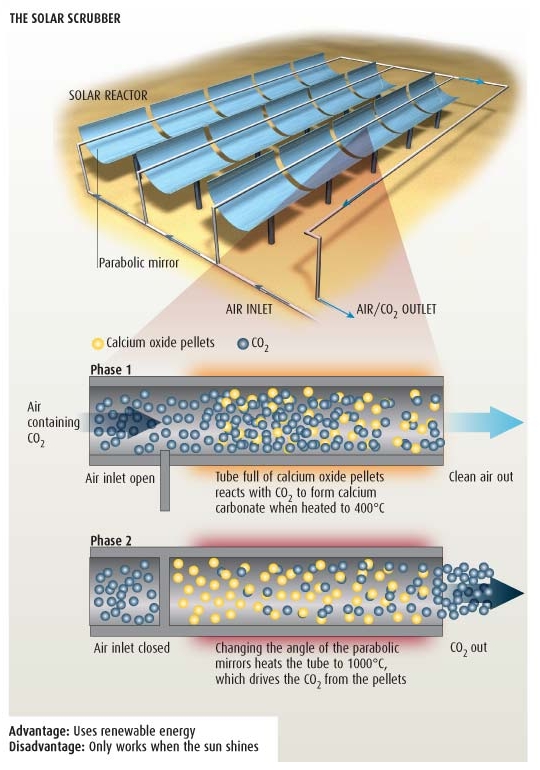Co2-filter: Unterschied zwischen den Versionen
Case (Diskussion | Beiträge) |
Case (Diskussion | Beiträge) |
||
| (2 dazwischenliegende Versionen desselben Benutzers werden nicht angezeigt) | |||
| Zeile 11: | Zeile 11: | ||
In less than 15 minutes, the pellets are mostly converted to calcium carbonate. At that point, Steinfeld closes the intake valve and intensifies the light, raising the temperature in the reactor to 800 °C. This drives off the CO2 as a stream of pure gas, which can be sent for sequestering, and converts the calcium carbonate back into calcium oxide. The researchers have run their reactor through five cycles of absorption and release with no decline in performance. Steinfeld believes his device could be scaled up to take significant amounts of CO2 out of the atmosphere, though as yet he doesn't know how much it would cost per tonne.'' | In less than 15 minutes, the pellets are mostly converted to calcium carbonate. At that point, Steinfeld closes the intake valve and intensifies the light, raising the temperature in the reactor to 800 °C. This drives off the CO2 as a stream of pure gas, which can be sent for sequestering, and converts the calcium carbonate back into calcium oxide. The researchers have run their reactor through five cycles of absorption and release with no decline in performance. Steinfeld believes his device could be scaled up to take significant amounts of CO2 out of the atmosphere, though as yet he doesn't know how much it would cost per tonne.'' | ||
| − | + | [[File:Cao-co2-filter.jpg| Kalziumoxid-Filtersystem]] | |
| − | |||
| − | |||
Das offensichtliche Problem dieser Methode ist der Energieaufwand für die jeweilige Reaktionstemperatur von 400°C bzw. 800°C . Aldo Steinfeld simuliert hier Sonneneinstrahlung mittels Lampen. Geplant ist aber, die Wärmeenergie durch Sonnenlicht zu erzeugen, was durch ein CSP-System vorstellbar bzw. möglich wäre. Dazu wird ein grosses Array von Spiegeln oder Hohlspiegeln gebraucht, die das Sonnenlicht auf eine Rohrleitung bündeln. Die Spiegel wiederum benötigen (wie fast alle CSP-Systeme) eine gesteuerte Nachführungsvorrichtung (Tracking-System). Alternativ wäre vielleicht auch eine elektrische Heizschlange denkbar die mit PV-Strom betrieben wird (Wirkungsgrad?). Kalziumcarbonat ist auch unter dem Namen Hühnerkalk erhältlich. | Das offensichtliche Problem dieser Methode ist der Energieaufwand für die jeweilige Reaktionstemperatur von 400°C bzw. 800°C . Aldo Steinfeld simuliert hier Sonneneinstrahlung mittels Lampen. Geplant ist aber, die Wärmeenergie durch Sonnenlicht zu erzeugen, was durch ein CSP-System vorstellbar bzw. möglich wäre. Dazu wird ein grosses Array von Spiegeln oder Hohlspiegeln gebraucht, die das Sonnenlicht auf eine Rohrleitung bündeln. Die Spiegel wiederum benötigen (wie fast alle CSP-Systeme) eine gesteuerte Nachführungsvorrichtung (Tracking-System). Alternativ wäre vielleicht auch eine elektrische Heizschlange denkbar die mit PV-Strom betrieben wird (Wirkungsgrad?). Kalziumcarbonat ist auch unter dem Namen Hühnerkalk erhältlich. | ||
| Zeile 31: | Zeile 29: | ||
[http://smartstones.nl/index.php/en Olivin - natürlicher CO2-Schlucker] | [http://smartstones.nl/index.php/en Olivin - natürlicher CO2-Schlucker] | ||
| + | |||
| + | [[Category: Energie]] | ||
Neueste Überarbeitung vom 11. September 2014, 17:12 Uhr
CO2 Gewinnung aus der Luft mit Filtern
CO2-Filterung mittels Kalziumoxid
(gefunden unter http://nextbigfuture.com/2009/01/co2-capture-from-air-for-fuel-or.html )
ETH's Steinfeld's reactor is a transparent tube filled with pellets of calcium oxide. In the table-top version the tube is a few centimetres high and an arc lamp replaces the sun. As the light heats the tube and its contents to 400 °C, air mixed with a small amount of steam is pumped in at the bottom and up through the pellets. At this temperature, the calcium oxide reacts with CO2 to form calcium carbonate. "By the time the air leaves, there is no CO2," says Steinfeld. "We go from 385 parts per million to practically zero."
In less than 15 minutes, the pellets are mostly converted to calcium carbonate. At that point, Steinfeld closes the intake valve and intensifies the light, raising the temperature in the reactor to 800 °C. This drives off the CO2 as a stream of pure gas, which can be sent for sequestering, and converts the calcium carbonate back into calcium oxide. The researchers have run their reactor through five cycles of absorption and release with no decline in performance. Steinfeld believes his device could be scaled up to take significant amounts of CO2 out of the atmosphere, though as yet he doesn't know how much it would cost per tonne.
Das offensichtliche Problem dieser Methode ist der Energieaufwand für die jeweilige Reaktionstemperatur von 400°C bzw. 800°C . Aldo Steinfeld simuliert hier Sonneneinstrahlung mittels Lampen. Geplant ist aber, die Wärmeenergie durch Sonnenlicht zu erzeugen, was durch ein CSP-System vorstellbar bzw. möglich wäre. Dazu wird ein grosses Array von Spiegeln oder Hohlspiegeln gebraucht, die das Sonnenlicht auf eine Rohrleitung bündeln. Die Spiegel wiederum benötigen (wie fast alle CSP-Systeme) eine gesteuerte Nachführungsvorrichtung (Tracking-System). Alternativ wäre vielleicht auch eine elektrische Heizschlange denkbar die mit PV-Strom betrieben wird (Wirkungsgrad?). Kalziumcarbonat ist auch unter dem Namen Hühnerkalk erhältlich.
Wikipedia Kalziumoxid Wikipedia Kalziumcarbonat
Literatur:
Separation of CO2 from Air by Temperature-Vacuum Swing Adsorption Using Diamine-Functionalized Silica Gel. Wurzbacher J., Gebald C., Steinfeld A Energy & Environmental Science, in press.
Amine-Based Nanofibrillated Cellulose As Adsorbent for CO2 Capture from Air. Gebald C., Wurzbacher J., Tingaut P., Zimmermann T., Steinfeld A. Environmental Science & Technology, in press.
